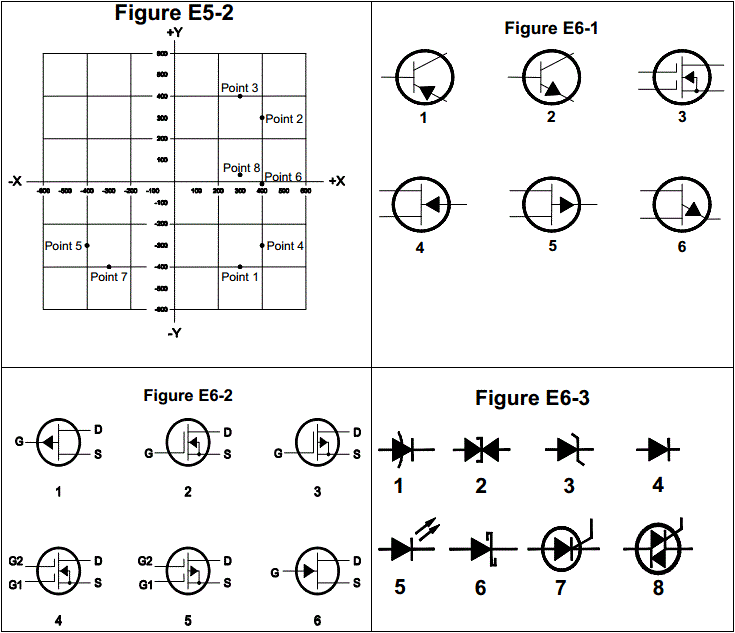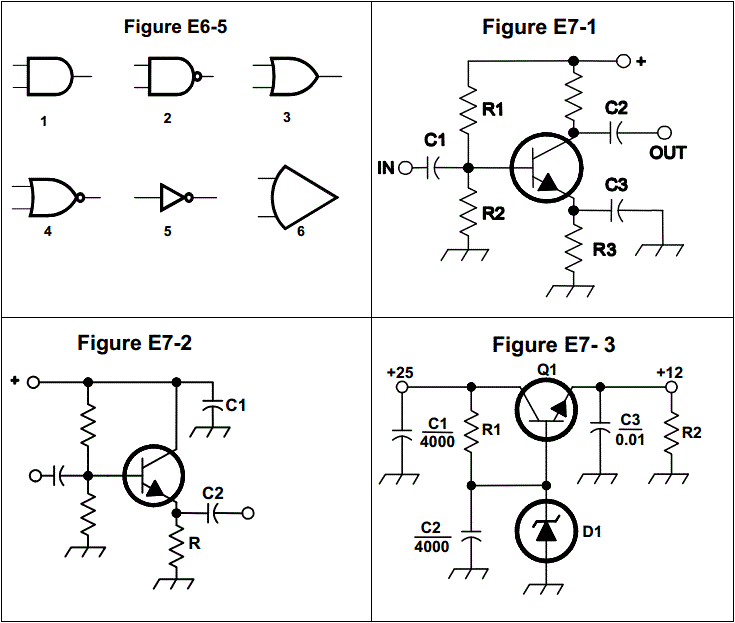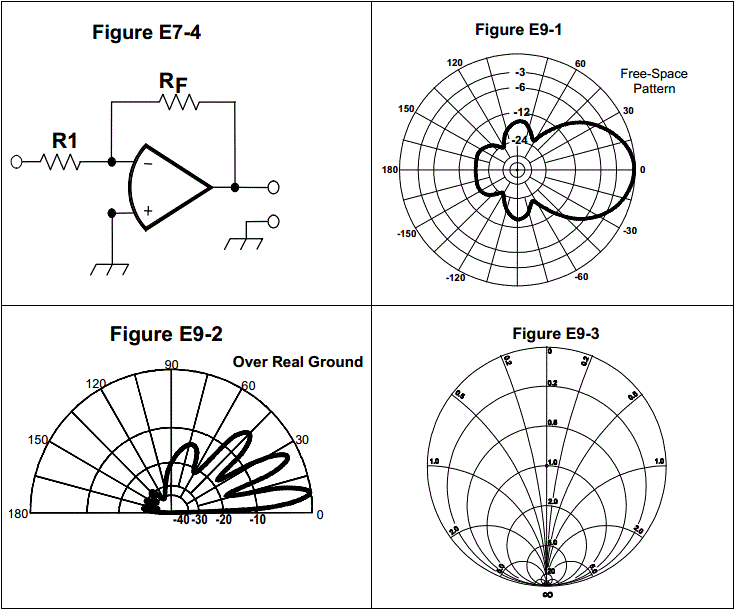Ham Extra License Practice Quiz
• Percentage: 0%; Correct: 0; Total: 0 of 50
E0A05: What is one of the potential hazards of using microwaves in the amateur radio bands?
Microwaves are ionizing radiation
The high gain antennas commonly used can result in high exposure levels
Microwaves often travel long distances by ionospheric reflection
The extremely high frequency energy can damage the joints of antenna structures
E1A03: With your transceiver displaying the carrier frequency of phone signals, you hear a DX station's CQ on 14.349 MHz USB. Is it legal to return the call using upper sideband on the same frequency?
Yes, because the DX station initiated the contact
Yes, because the displayed frequency is within the 20 meter band
No, my sidebands will extend beyond the band edge
No, USA stations are not permitted to use phone emissions above 14.340 MHz
E1B10: What frequencies are authorized to an amateur station participating in RACES?
All amateur service frequencies authorized to the control operator
Specific segments in the amateur service MF, HF, VHF and UHF bands
Specific local government channels
Military Affiliate Radio System (MARS) channels
E1C03: How do the control operator responsibilities of a station under automatic control differ from one under local control?
Under local control there is no control operator
Under automatic control the control operator is not required to be present at the control point
Under automatic control there is no control operator
Under local control a control operator is not required to be present at a control point
E1D02: What is the amateur satellite service?
A radio navigation service using satellites for the purpose of self training, intercommunication and technical studies carried out by amateurs
A spacecraft launching service for amateur-built satellites
A radio communications service using amateur radio stations on satellites
A radio communications service using stations on Earth satellites for public service broadcast
E1E07: What should a VE do if a candidate fails to comply with the examiner's instructions during an amateur operator license examination?
Warn the candidate that continued failure to comply will result in termination of the examination
Immediately terminate the candidate's examination
Allow the candidate to complete the examination, but invalidate the results
Immediately terminate everyones examination and close the session
E1F13: What types of communications may be transmitted to amateur stations in foreign countries?
Business-related messages for non-profit organizations
Messages intended for connection to users of the maritime satellite service
Communications incidental to the purpose of the amateur service and remarks of a personal nature
All of these choices are correct
E2A01: What is the direction of an ascending pass for an amateur satellite?
From west to east
From east to west
From south to north
From north to south
E2B14: What aspect of an amateur slow-scan television signal encodes the brightness of the picture?
Tone frequency
Tone amplitude
Sync amplitude
Sync frequency
E2C06: During a VHF/UHF contest, in which band segment would you expect to find the highest level of activity?
At the top of each band, usually in a segment reserved for contests
In the middle of each band, usually on the national calling frequency
In the weak signal segment of the band, with most of the activity near the calling frequency
In the middle of the band, usually 25 kHz above the national calling frequency
E2D10: How can an APRS station be used to help support a public service communications activity?
An APRS station with an emergency medical technician can automatically transmit medical data to the nearest hospital
APRS stations with General Personnel Scanners can automatically relay the participant numbers and time as they pass the check points
An APRS station with a GPS unit can automatically transmit information to show a mobile station's position during the event
All of these choices are correct
E2E06: What is the most common data rate used for HF packet communications?
48 baud
110 baud
300 baud
1200 baud
E3A03: When scheduling EME contacts, which of these conditions will generally result in the least path loss?
When the Moon is at perigee
When the Moon is full
When the Moon is at apogee
When the MUF is above 30 MHz
E3B01: What is transequatorial propagation?
Propagation between two mid-latitude points at approximately the same distance north and south of the magnetic equator
Propagation between any two points located on the magnetic equator
Propagation between two continents by way of ducts along the magnetic equator
Propagation between two stations at the same latitude
E3C03: Where in the ionosphere does Aurora activity occur?
In the F1-region
In the F2-region
In the D-region
In the E-region
E4A07: Which of the following is an advantage of using an antenna analyzer compared to an SWR bridge to measure antenna SWR?
Antenna analyzers automatically tune your antenna for resonance
Antenna analyzers do not need an external RF source
Antenna analyzers display a time-varying representation of the modulation envelope
All of these choices are correct
E4B07: Which of the following is good practice when using an oscilloscope probe?
Keep the signal ground connection of the probe as short as possible
Never use a high impedance probe to measure a low impedance circuit
Never use a DC-coupled probe to measure an AC circuit
All of these choices are correct
E4C14: On which of the following frequencies might a signal be transmitting which is generating a spurious image signal in a receiver tuned to 14.300 MHz and which uses a 455 kHz IF frequency?
13.845 MHz
14.755 MHz
14.445 MHz
15.210 MHz
E4D06: What is the term for unwanted signals generated by the mixing of two or more signals?
Amplifier desensitization
Neutralization
Adjacent channel interference
Intermodulation interference
E4E13: What might be the cause of a loud roaring or buzzing AC line interference that comes and goes at intervals?
Arcing contacts in a thermostatically controlled device
A defective doorbell or doorbell transformer inside a nearby residence
A malfunctioning illuminated advertising display
All of these choices are correct
E5A06: What is the magnitude of the circulating current within the components of a parallel LC circuit at resonance?
It is at a minimum
It is at a maximum
It equals 1 divided by the quantity 2 times Pi, multiplied by the square root of inductance L multiplied by capacitance C
It equals 2 multiplied by Pi, multiplied by frequency "F", multiplied by inductance "L"
E5B12: What is the phase angle between the voltage across and the current through a series RLC circuit if XC is 75 ohms, R is 100 ohms, and XL is 50 ohms?
76 degrees with the voltage lagging the current
14 degrees with the voltage leading the current
14 degrees with the voltage lagging the current
76 degrees with the voltage leading the current
E5C21: Which point on Figure E5-2 best represents the impedance of a series circuit consisting of a 300 ohm resistor and a 19 picofarad capacitor at 21.200 MHz?
Point 1
Point 3
Point 7
Point 8
E5D02: Why is the resistance of a conductor different for RF currents than for direct currents?
Because the insulation conducts current at high frequencies
Because of the Heisenburg Effect
Because of skin effect
Because conductors are non-linear devices
E6A03: What are the majority charge carriers in P-type semiconductor material?
Free neutrons
Free protons
Holes
Free electrons
E6B01: What is the most useful characteristic of a Zener diode?
A constant current drop under conditions of varying voltage
A constant voltage drop under conditions of varying current
A negative resistance region
An internal capacitance that varies with the applied voltage
E6C04: Which of the following is the primary advantage of tri-state logic?
Low power consumption
Ability to connect many device outputs to a common bus
High speed operation
More efficient arithmetic operations
E6D02: Exceeding what design rating can cause a cathode ray tube (CRT) to generate X-rays?
The heater voltage
The anode voltage
The operating temperature
The operating frequency
E6E09: Which of the following must be done to insure that a crystal oscillator provides the frequency specified by the crystal manufacturer?
Provide the crystal with a specified parallel inductance
Provide the crystal with a specified parallel capacitance
Bias the crystal at a specified voltage
Bias the crystal at a specified current
E6F11: Which of the following is the approximate open-circuit voltage produced by a fully-illuminated silicon photovoltaic cell?
0.1 V
0.5 V
1.5 V
12 V
E7A15: What is a D flip-flop?
A flip-flop whose output takes on the state of the D input when the clock signal transitions from low to high
A differential class D amplifier used as a flip-flop circuit
A dynamic memory storage element
A flip-flop whose output is capable of both positive and negative voltage excursions
E7B19: What is a klystron?
A high speed multivibrator
An electron-coupled oscillator utilizing a pentode vacuum tube
An oscillator utilizing ceramic elements to achieve stability
A VHF, UHF, or microwave vacuum tube that uses velocity modulation
E7C13: What is one advantage of a Pi matching network over an L matching network consisting of a single inductor and a single capacitor?
The Q of Pi networks can be varied depending on the component values chosen
L networks cannot perform impedance transformation
Pi networks have fewer components
Pi networks are designed for balanced input and output
E7D06: What is the purpose of Q1 in the circuit shown in Figure E7-3?
It provides negative feedback to improve regulation
It provides a constant load for the voltage source
It increases the current-handling capability of the regulator
It provides D1 with current
E7E06: Why is de-emphasis commonly used in FM communications receivers?
For compatibility with transmitters using phase modulation
To reduce impulse noise reception
For higher efficiency
To remove third-order distortion products
E7F06: What is one purpose of a marker generator?
To add audio markers to an oscilloscope
To provide a frequency reference for a phase locked loop
To provide a means of calibrating a receiver's frequency settings
To add time signals to a transmitted signal
E7G06: Which of the following is the most appropriate use of an op-amp active filter?
As a high-pass filter used to block RFI at the input to receivers
As a low-pass filter used between a transmitter and a transmission line
For smoothing power-supply output
As an audio filter in a receiver
E7H01: What are three oscillator circuits used in Amateur Radio equipment?
Taft, Pierce and negative feedback
Pierce, Fenner and Beane
Taft, Hartley and Pierce
Colpitts, Hartley and Pierce
E8A06: What is the approximate ratio of PEP-to-average power in a typical single-sideband phone signal?
2.5 to 1
25 to 1
1 to 1
100 to 1
E8B05: What is the deviation ratio of an FM-phone signal having a maximum frequency swing of plus-or-minus 5 kHz when the maximum modulation frequency is 3 kHz?
60
0.167
0.6
1.67
E8C11: What spread-spectrum communications technique uses a high speed binary bit stream to shift the phase of an RF carrier?
Frequency hopping
Direct sequence
Binary phase-shift keying
Phase compandored spread-spectrum
E8D06: What is the advantage of using a peak-reading wattmeter to monitor the output of a SSB phone transmitter?
It is easier to determine the correct tuning of the output circuit
It gives a more accurate display of the PEP output when modulation is present
It makes it easier to detect high SWR on the feed line
It can determine if any flat-topping is present during modulation peaks
E9A01: Which of the following describes an isotropic antenna?
A grounded antenna used to measure earth conductivity
A horizontally polarized antenna used to compare Yagi antennas
A theoretical antenna used as a reference for antenna gain
A spacecraft antenna used to direct signals toward the earth
E9B11: What is a disadvantage of decreasing the number of wire segments in an antenna model below the guideline of 10 segments per half-wavelength?
Ground conductivity will not be accurately modeled
The resulting design will favor radiation of harmonic energy
The computed feed point impedance may be incorrect
The antenna will become mechanically unstable
E9C09: What is the front-to-back ratio of the radiation pattern shown in Figure E9-2?
15 dB
28 dB
3 dB
24 dB
E9D15: Which of the following would provide the best RF ground for your station?
A 50-ohm resistor connected to ground
An electrically-short connection to a metal water pipe
An electrically-short connection to 3 or 4 interconnected ground rods driven into the Earth
An electrically-short connection to 3 or 4 interconnected ground rods via a series RF choke
E9E05: How must the driven element in a 3-element Yagi be tuned to use a hairpin matching system?
The driven element reactance must be capacitive
The driven element reactance must be inductive
The driven element resonance must be lower than the operating frequency
The driven element radiation resistance must be higher than the characteristic impedance of the transmission line
E9F01: What is the velocity factor of a transmission line?
The ratio of the characteristic impedance of the line to the terminating impedance
The index of shielding for coaxial cable
The velocity of the wave in the transmission line multiplied by the velocity of light in a vacuum
The velocity of the wave in the transmission line divided by the velocity of light in a vacuum
E9G06: On the Smith chart shown in Figure E9-3, what is the name for the large outer circle on which the reactance arcs terminate?
Prime axis
Reactance axis
Impedance axis
Polar axis
E9H10: How can the output voltage of a multi-turn receiving loop antenna be increased?
By reducing the permeability of the loop shield
By increasing the number of wire turns in the loop and reducing the area of the loop structure
By winding adjacent turns in opposing directions
By increasing either the number of wire turns in the loop or the area of the loop structure or both



